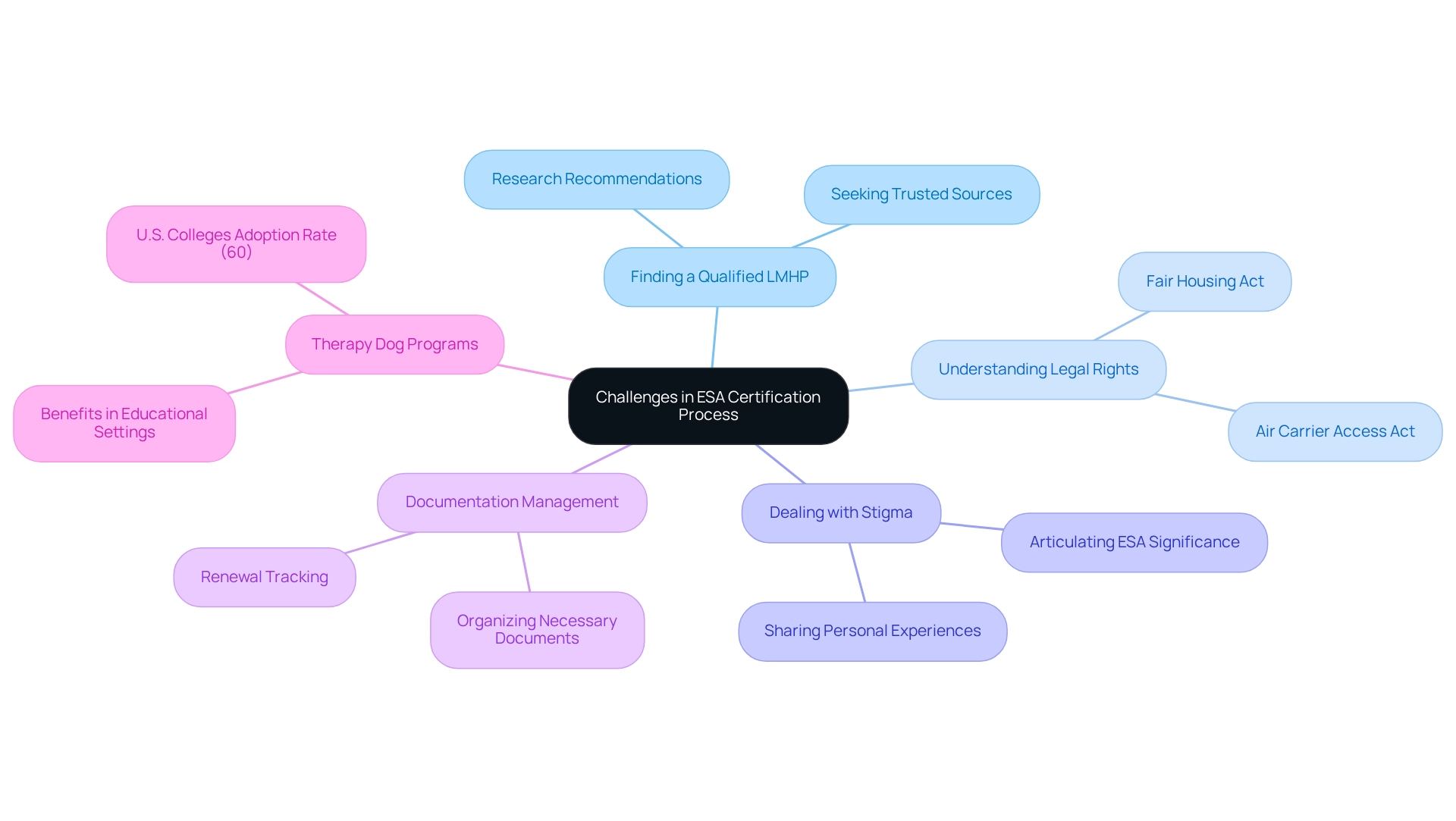

How to Get My Dog Emotional Support Certified: A Step-by-Step Guide
by Lena Park
Last updated: July 9, 2025
Verified and Approved by:
Angela Morris,
MSW, LCSW
Fact Checked

Overview
If you’re seeking emotional support for your dog, it’s important to first connect with a licensed mental health professional (LMHP). They can help assess your psychological condition and determine whether an Emotional Support Animal (ESA) could be a beneficial part of your treatment.
Many individuals face emotional challenges that can feel overwhelming, and understanding this struggle is the first step toward healing. Once you’ve had your assessment, if approved, you can expect to receive an official ESA letter within 24 hours.
This letter is vital for accessing housing and travel rights associated with having an ESA, providing you with the support you need during difficult times. Services like Wellness Wag are committed to making this process as seamless as possible, ensuring that you feel cared for and supported every step of the way.
Introduction
In a world where mental health issues are increasingly recognized, many individuals find themselves grappling with emotional and psychological challenges. These struggles can feel overwhelming, leaving one yearning for comfort and stability.
Emotional Support Animals (ESAs) have emerged as vital companions during such times, offering a unique form of support. Unlike service animals, which are trained for specific tasks, ESAs provide solace, playing a crucial role in alleviating symptoms of anxiety, depression, and PTSD.
As research highlights the significant benefits of these animals, it becomes essential to understand the process of obtaining an ESA letter. This article delves into the steps necessary to secure an ESA letter, the eligibility criteria, and the potential challenges one might encounter along the way.
For those considering this supportive option, there is hope and guidance available.
Understand the Role of Emotional Support Animals
Emotional Support Animals (ESAs) are essential companions for those navigating the challenges of emotional or psychological conditions. Unlike service animals, which are specifically trained to assist individuals with disabilities, ESAs primarily offer comfort and emotional stability. Research has shown that ESAs can significantly alleviate symptoms of anxiety, depression, and PTSD, fostering an improved sense of psychological well-being. For instance, studies reveal that individuals with ESAs often experience lower anxiety levels and enhanced physical wellness indicators, such as reduced blood pressure, highlighting their dual benefits. A study titled “Research on the Benefits of Emotional Support Animals” underscores that ESAs not only provide emotional support but also positively influence physical health, reinforcing their importance in psychological care.
The bond between an owner and their ESA is crucial, nurturing a sense of safety and companionship that can be transformative for those facing health challenges. If you are living with emotional or mental disabilities, you might be wondering how to get your dog emotional support certified, which can grant specific housing and travel rights through an ESA document. With Wellness Wag, you can easily learn how to get your dog emotional support certified, and the process of obtaining your ESA documentation is both economical and efficient, starting at just $32.25 with interest-free payment options available. To begin, you will answer a few brief questions about your ESA needs and consult with a licensed medical professional for expert guidance. Once approved, you will receive your emotional support animal letter within 24 hours. This legal recognition is vital for those who may face restrictions in pet-friendly accommodations or during travel.
As psychological well-being continues to be a significant topic in national conversations, the relevance of ESAs is anticipated to grow. Mental wellness experts advocate for the inclusion of ESAs in therapeutic settings, highlighting their role in providing emotional support that complements traditional treatment methods. It is essential to understand the distinct role of ESAs compared to service animals, as this knowledge reveals the unique benefits and legal protections associated with having an ESA. Wellness Wag also offers a money-back guarantee, ensuring client satisfaction, and numerous testimonials from grateful clients illustrate the seamless ESA approval process.
Determine Eligibility for an ESA Letter
To be eligible for an Emotional Support Animal (ESA) document, individuals must have a diagnosed psychological condition that significantly impacts their daily life. In 2025, approximately 30% of adults in the U.S. report experiencing anxiety, depression, or PTSD, highlighting the prevalence of these conditions. Common psychological concerns that qualify for an ESA letter include:
- Anxiety disorders
- Major depressive disorder
- Post-traumatic stress disorder
The first step in this process is to consult with a licensed mental health professional (LMHP). This could be a psychologist, psychiatrist, or licensed therapist who can perform a thorough assessment of your psychological background and current difficulties. During this assessment, it’s crucial to discuss how an ESA could support your treatment plan. If the LMHP determines that an ESA is beneficial for your psychological well-being, they will provide a formal ESA letter.
Emotional Support Animals offer essential comfort and assistance, especially for students with disabilities, by alleviating symptoms associated with their conditions. They are permitted in university housing, promoting equal opportunities for students to fully embrace residential life. It’s important to note that as of January 2021, the U.S. Department of Transportation no longer recognizes ESAs as service animals, which affects travel regulations. Therefore, understanding local guidelines and state-specific conditions regarding ESA rights is vital. Additionally, licensed therapists can now write ESA documents after assessing a client’s mental health condition, expanding access to this important support.
For those wondering how to get my dog emotional support certified, it’s advisable to seek out a qualified LMHP who understands the intricacies of ESA documentation. Wellness Wag provides an efficient online process through its telehealth services, making it easier to acquire valid ESA documents. This ensures you receive a document that meets legal requirements and effectively upholds your rights under the Fair Housing Act and Air Carrier Access Act. After your discussion with an LMHP, you can expect guidance on how to get my dog emotional support certified and the next steps in obtaining your ESA documentation.
Follow the Steps to Obtain Your ESA Letter
To obtain your ESA document, follow these steps:
- Consult a Licensed Behavioral Specialist: Arrange a meeting with a licensed behavioral specialist (LMHP). This can be done in person or via telehealth, which has become increasingly popular, allowing for greater accessibility and convenience. It is important to note that legitimate ESA letters must be composed and signed by a licensed practitioner in your state to ensure validity. During the consultation, discuss your needs by openly talking about your psychological challenges and how to get my dog emotional support certified to aid in your treatment with an emotional support animal (ESA). Be honest and thorough in your responses to ensure the LMHP understands your situation fully. This step is crucial as emotional support animals illustrate how to get my dog emotional support certified, providing essential emotional support, particularly for individuals facing mental health challenges, and are permitted in university housing to promote equal opportunities for students.
- Obtain Your ESA Documentation: If the LMHP concludes that an ESA is advantageous for your treatment, they will provide a document on their official letterhead. This document must include your diagnosis, the recommendation for an ESA, and the LMHP’s contact information. Clients usually obtain their official ESA document within 24 hours following approval, greatly decreasing the wait time in comparison to conventional methods. With Wellness Wag, this process is streamlined, ensuring you get the support you need quickly.
- Maintain Your Document Current: ESA documents typically require renewal each year. Keep consistent communication with your mental health provider to ensure your documentation remains valid and reflects your current needs. This proactive approach helps you secure necessary accommodations for your emotional support animal.
- Consider the benefits of knowing how to get my dog emotional support certified: Securing an ESA document online reflects the conventional procedure but provides considerable advantages regarding convenience and speed, enabling clients to avoid lengthy wait periods for appointments and documentation. At Wellness Wag, you can take a quick assessment to tailor services to your emotional support needs, linking you with a licensed medical professional for a personalized consultation and thorough evaluation.
Navigate Challenges in the ESA Certification Process
Obtaining an ESA letter can be a straightforward process, yet it often comes with challenges that require careful navigation. Many individuals face the emotional struggle of finding a qualified licensed mental health professional (LMHP) who understands ESA letters. It can be daunting to locate someone experienced in this area, but conducting thorough research and seeking recommendations from trusted sources can make a significant difference. It’s important to recognize that many participants with mood disorders seeking ESAs report a mean rank of 4.5, highlighting the pressing need for qualified support in this process.
Understanding your legal rights is equally crucial. Familiarizing yourself with the Fair Housing Act and the Air Carrier Access Act empowers you to advocate for yourself as an ESA owner. Being aware of these laws ensures that you can effectively communicate your needs to landlords or airlines. As noted by Russell, measures related to loneliness show good internal consistency and reliability, underscoring the emotional benefits that ESAs can provide.
Dealing with stigma can be another hurdle. The concept of emotional support animals is still misunderstood by some, making it important for you to articulate the significance of your ESA and the emotional benefits it offers. Sharing personal experiences or insights from mental wellness professionals can be helpful, as they often emphasize the therapeutic role of ESAs in alleviating loneliness and enhancing well-being. For instance, professionals frequently highlight how ESAs can significantly improve emotional health, making it essential to communicate their value effectively.
Additionally, keeping track of when your ESA document needs renewal is vital. Ensure that you have all necessary documentation organized and readily available for housing or travel accommodations. This proactive approach can help mitigate potential issues and ensure a smoother experience. Working with reputable providers and licensed professionals is crucial to securing your rights regarding ESA letters, as this can greatly influence the overall process.
It’s also worth noting that therapy dog programs in educational settings have shown significant benefits, with U.S. colleges reporting a 60% adoption rate. These programs not only support students’ emotional well-being but also enhance academic performance, illustrating the broader impact of emotional support animals in various environments. By understanding these challenges and preparing accordingly, you can navigate the ESA certification process more effectively, learning how to get your dog emotional support certified while receiving the support you deserve.

Conclusion
Emotional Support Animals (ESAs) are truly invaluable for individuals grappling with emotional and psychological challenges. Their unique ability to provide comfort and companionship transcends traditional pet ownership, offering significant relief from conditions such as anxiety, depression, and PTSD. For those seeking the benefits of these remarkable animals, obtaining an ESA letter is a vital step, granting legal recognition and access to essential housing and travel rights.
Navigating the process of acquiring an ESA letter begins with a heartfelt consultation with a licensed mental health professional. This compassionate assessment ensures that individual needs are understood and documented appropriately. Thankfully, this streamlined process can often be completed online, allowing individuals to receive timely support tailored to their specific circumstances.
While there may be hurdles, such as finding qualified professionals and understanding legal rights, being informed and prepared can ease the journey. The advantages of having an ESA extend far beyond emotional support; they can also enhance physical health and enrich overall quality of life. As awareness of the importance of ESAs continues to flourish, these animals hold the promise of being integrated into various therapeutic settings, offering hope and stability to those in need. Remember, you are not alone in this journey; support is available, and ESAs can be a beacon of light in the path to healing.
Frequently Asked Questions
What are Emotional Support Animals (ESAs)?
Emotional Support Animals (ESAs) are companions that provide comfort and emotional stability to individuals facing emotional or psychological conditions. Unlike service animals, ESAs are not specifically trained to assist with disabilities but primarily offer emotional support.
How do ESAs benefit individuals with mental health conditions?
Research indicates that ESAs can significantly alleviate symptoms of anxiety, depression, and PTSD, leading to improved psychological well-being. Individuals with ESAs often experience lower anxiety levels and better physical wellness indicators, such as reduced blood pressure.
What is the process for getting a dog certified as an emotional support animal?
To get a dog emotional support certified, you can consult with Wellness Wag, which offers an economical and efficient process starting at $32.25. You will answer a few questions about your ESA needs and consult with a licensed medical professional. Once approved, you will receive your ESA letter within 24 hours.
What legal rights do ESAs provide?
An ESA letter grants specific housing and travel rights, allowing individuals to avoid restrictions in pet-friendly accommodations and during travel.
How do ESAs differ from service animals?
ESAs primarily provide emotional support and comfort, while service animals are specifically trained to assist individuals with disabilities. Understanding this distinction reveals the unique benefits and legal protections associated with having an ESA.
What guarantees does Wellness Wag offer for their ESA certification process?
Wellness Wag offers a money-back guarantee to ensure client satisfaction, along with numerous testimonials from clients who have successfully navigated the ESA approval process.
What is the anticipated future relevance of ESAs in mental health care?
As discussions around psychological well-being continue to grow, the relevance of ESAs is expected to increase. Mental wellness experts advocate for their inclusion in therapeutic settings, emphasizing their role in providing emotional support that complements traditional treatment methods.
Certify Your Emotional Support Animal Today

Why You Can Rely on Us?
At Wellness Wag, we believe your pet deserves care rooted in both science and compassion. Each article is carefully researched, written in clear language for pet owners, and then reviewed by qualified professionals to ensure the information is evidence-based, current, and practical for real-life care. Our goal is to help you feel confident in making informed decisions about your pet’s health and well-being.
Reviewed by
Angela Morris, MSW, LCSW
Angela is a licensed clinical social worker with 20 years of experience in patient advocacy and community mental health. She has assisted numerous clients with ESA evaluations and brings a deep understanding of disability accommodations, ensuring that all information is accurate, supportive, and practical.

Written by :
Lena Park
Last Updated :
July 9, 2025












